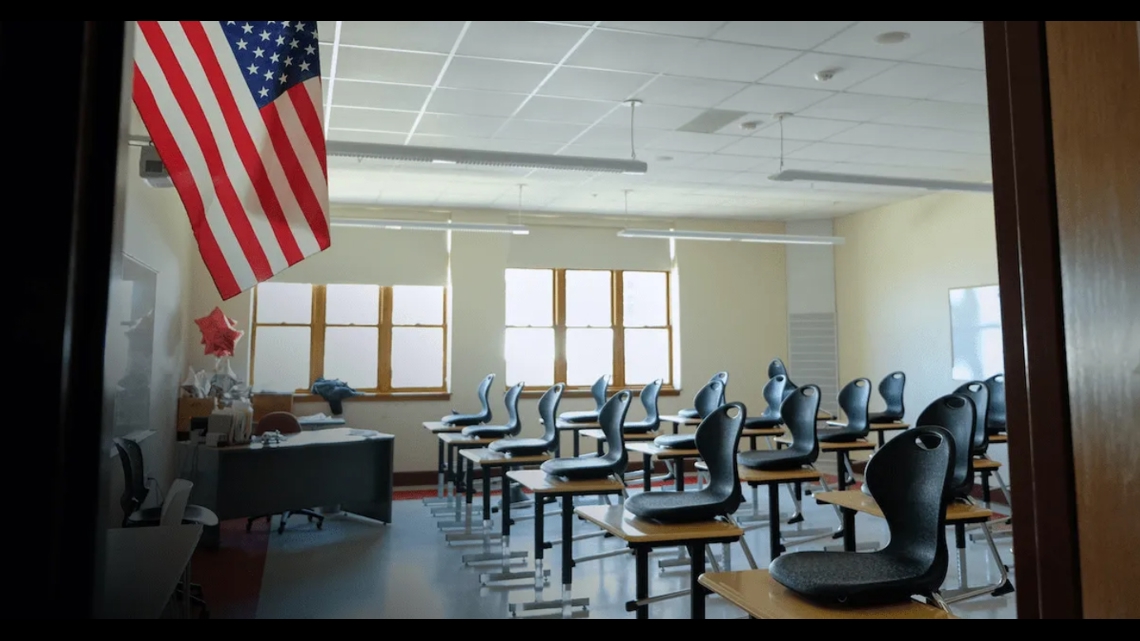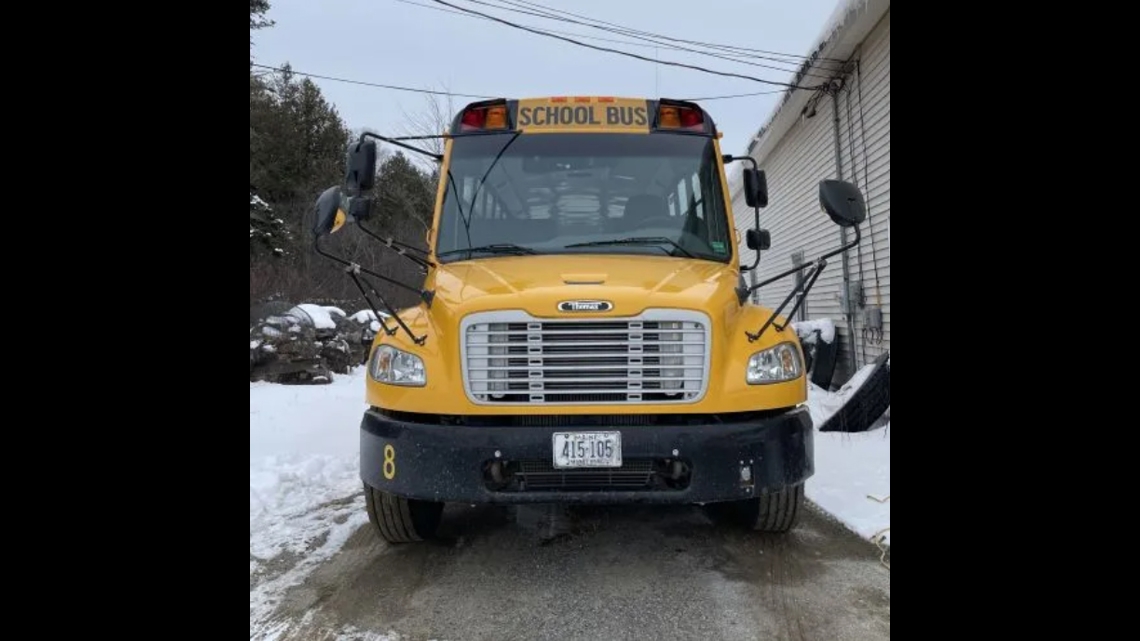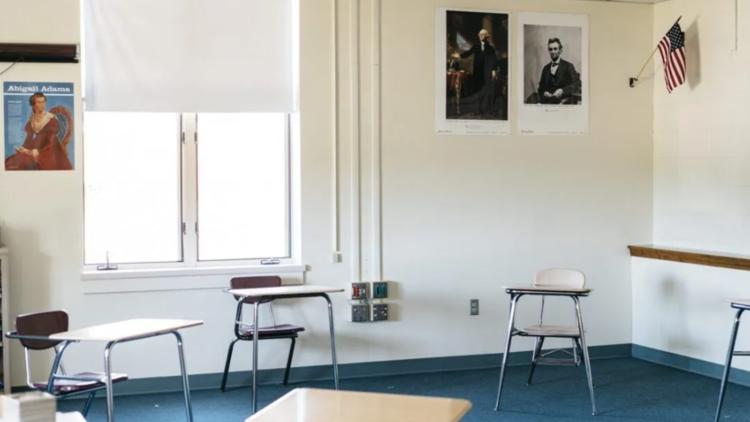MAINE, USA — Kennedy Raymond started her sixth year of teaching at Lewiston’s Robert V. Connors Elementary School with the biggest classroom she ever had to lead.
With 25 students, Raymond, who had just started to feel like a veteran teacher, did not know what to expect. On the first day, she told herself she could handle a big class. By the second day, she was overwhelmed.
“I felt like I was tripping over kids, over furniture, all day long,” she said. “I just couldn’t do it. I couldn’t possibly meet the needs of every kid, both academically and … the kids were also overwhelmed.”
Through the school year, her class size reduced slightly, from 25 to 21 students. But Raymond said this has been her toughest year managing a classroom, and she’s felt burned out for months.
This year, for the first time, she does not see herself teaching summer school, which she typically loved doing.
“By whatever our last day is, there will be nothing left for me to give,” she said. “Right now it already feels like I’m scraping the bottom every day to show up for my students.”
In Maine, ongoing educator shortages have gotten more dire this year, leaving district leaders and teachers concerned about being overworked and undercompensated, and unable to meet their students’ needs.
The shortages have had direct consequences for students, including overcrowded classrooms, lack of individual attention, and insufficient resources for special education, according to several district leaders, teachers and teachers’ union leaders. In the upcoming school year, staffing shortages are expected to continue.
Shortages have been commonly linked to low wages for educators across the country, and Maine is no exception.
The Maine Education Association, which represents thousands of teachers and other school staff, has been fighting for bills that would increase minimum salaries for teachers from $40,000 to $50,000, minimum hourly wages for ed techs to 150 percent of the state minimum wage, and for other support staff wages to be raised to 125 percent of the minimum wage.
But those bills may not pass.
According to the National Education Association, only eight states and the District of Columbia offer more than $50,000 as the minimum.
“Primarily the issues are the pay for the work that they do, and then the workload, which is exacerbated by the shortages,” said Grace Leavitt, president of the MEA. “If there’s a vacancy that isn’t filled, somebody’s covering that work somehow in addition to their own.”
Schools with severe shortages come close to shutting down
There is no statewide database on how many open positions schools have listed.
But based on district job posting data, there are hundreds of openings across the state for teachers, administrators, education technicians, food service workers, bus drivers, school support staff and part-time substitutes.
As of early May, Lewiston schools had the most open positions, with 131 job openings listed on ServingSchools.com, a hiring platform used by many districts in the state.


The district has plugged staffing holes with long-term substitutes, but because teachers are already overworked, at least 40 people in classrooms daily are not qualified, said Lewiston Superintendent Jake Langlais. That can mean they’re teaching without certification, or are substitute teachers or ed techs.
At least a half-dozen times this year, the district counted on staff to try and determine if school had to be canceled that day.
“We have closed some parts of schools, like a wing or a program, on at least three different occasions during the current school year because of staffing limitations,” said Langlais.
Langlais has spent a handful of days covering for principals, or even teaching because of teacher shortages.
“We have built plans in our district for multiple people — including building administration, district administration and myself — to go be in schools, if that’s what it takes to be open.”
Shortages are uneven across the state
Not every part of the state is dealing with the same magnitude of shortages. Portland and Bangor schools each had more than 30 open positions this week, based on job listing data, not including summer school listings.
But teaching positions that districts need to fill for next year may not be listed yet, according to some superintendents, who said they expect to add teaching positions.
For example, Bangor schools need to fill 15 teaching positions, many in special education, for next year that aren’t advertised yet, according to Superintendent James Tager.
Although Tager said Bangor schools have not seen a large-scale impact on classrooms, and have been able to keep the 15:1 student-teacher ratio mostly stable, they have relied on substitute teachers, and are worried about open teaching positions for the upcoming school year.


The district used COVID-19 funding through this school year to hire long-term substitutes at every elementary school, two at the middle schools and one at the high school, which Tager said has been useful for having a designated substitute to help with staffing needs that may arise.
The positions are not in the budget for next year, and because COVID relief money given to districts during the pandemic will no longer be available starting in September, Bangor can’t pay for long-term substitutes next year.
Some districts, like Lewiston, added long-term substitutes to their budget for next year, but because Bangor schools are already asking for almost a 7 percent budget increase to make sure educators are well-paid, they don’t have funding for long-term substitutes in the next school year, Tager said.
Another big challenge for the district has been the decline in the number of applicants for open positions, which has made hiring qualified teachers difficult, Tager said.
“We have less applicants for the jobs that we want, so it’s taking longer to screen and find somebody that’s good,” he said.
Bus driver shortages across Maine
Although Bangor schools contract with Cyr Bus Lines for driver positions, the district has faced challenges filling positions. Although students have not missed school days, some extracurricular activities — such as getting students to sports events — have been impacted.
Other districts have consolidated bus routes to get students to and from school, said Scott Porter, the Machias Bay area superintendent.
The district, which serves about 11 Washington County towns, has about 20 jobs open, based on job listing data, including a teaching principal, ed techs and bus drivers. The transportation issue in particular has been challenging, Porter said.
“Instead of doing a regular run, we have bus drivers doing two runs, or they’re doing a longer run,” he said. “We’re making it work, we’re getting kids back and forth, but they may not be at the exact times they had been in years past.”
The Washington County district also has fewer applicants than previous years for open teacher and support staff positions, Porter said. Until teachers, ed techs and bus drivers are paid fairly, he said, he does not blame them for choosing other jobs.
“I think it is going to continue to be challenging,” Porter said. “I don’t think this is going to change for a while — until wages go up.”
Ed Tech pay holds people back from the profession
Kim Hubbard has been an education technician in the same district, RSU 57, which serves York County, for 20 years, and has worked with a special education teacher for 15, offering personal help for students with individualized education programs. Part of her job is to go to classrooms to help students, but instead of one grade she’s now juggling students from four grades in five classrooms.
On a typical day, Hubbard goes in early to plan lessons, then spends as much time as possible in classrooms, knowing even if she cuts her time in half in one class, it will make her late to get to the next one because of her packed schedule.
“I don’t think I’m as effective as I should be,” she said. “And kids are suffering.”
Even during lunch breaks, or when she’s teaching small group classes, Hubbard allows other students to work in her office because double booking is the only way she can attempt to meet the needs of all her students, she said.
Her job would be much more attractive to her if she wasn’t making less than $20 an hour. Last year Hubbard testified in support of increasing minimum wages for support staff, claiming that no ed tech should be expected to stay in a profession that pays less than a Walmart shelf stocking job.
“The responsibilities have more than doubled but the pay has barely kept up with inflation,” Hubbard said. “We don’t have a shortage of people who want to be ed techs, we just have a shortage of people who can afford to be ed techs.”
This story was originally published by The Maine Monitor, a nonprofit and nonpartisan news organization. To get regular coverage from the Monitor, sign up for a free Monitor newsletter here.



